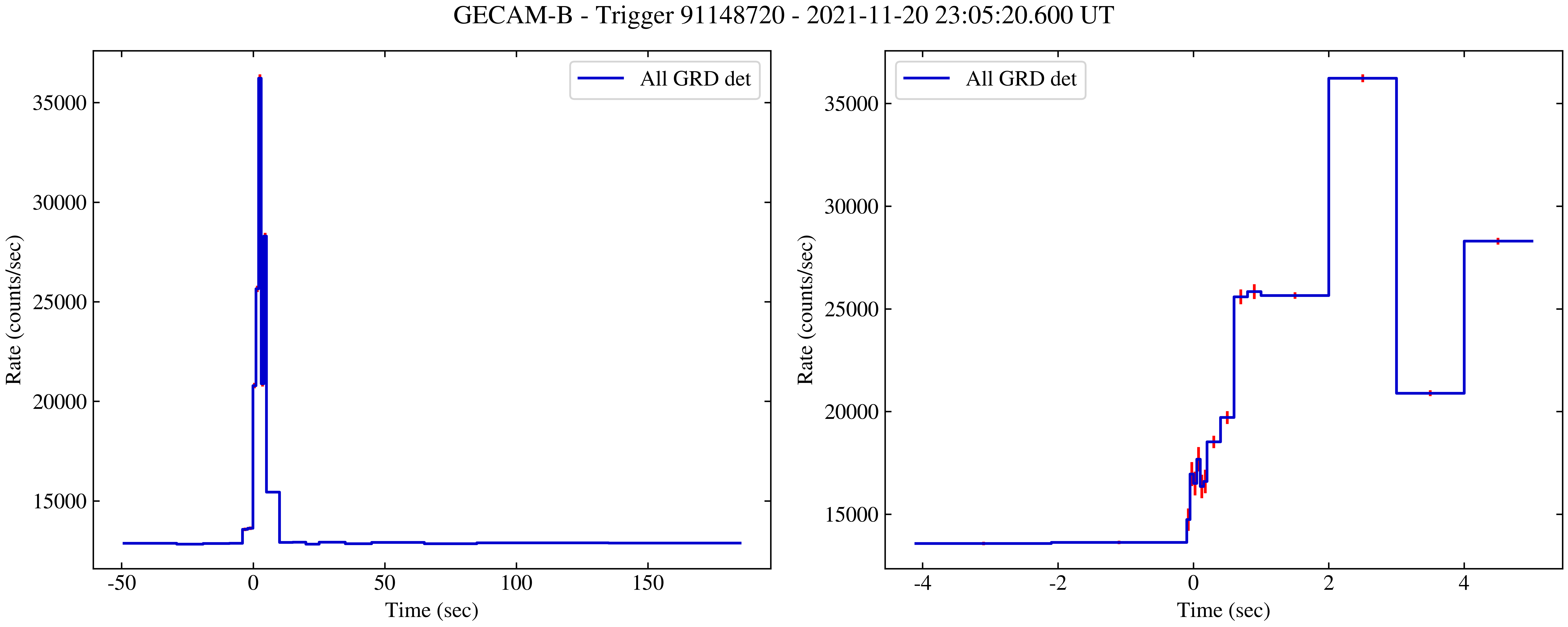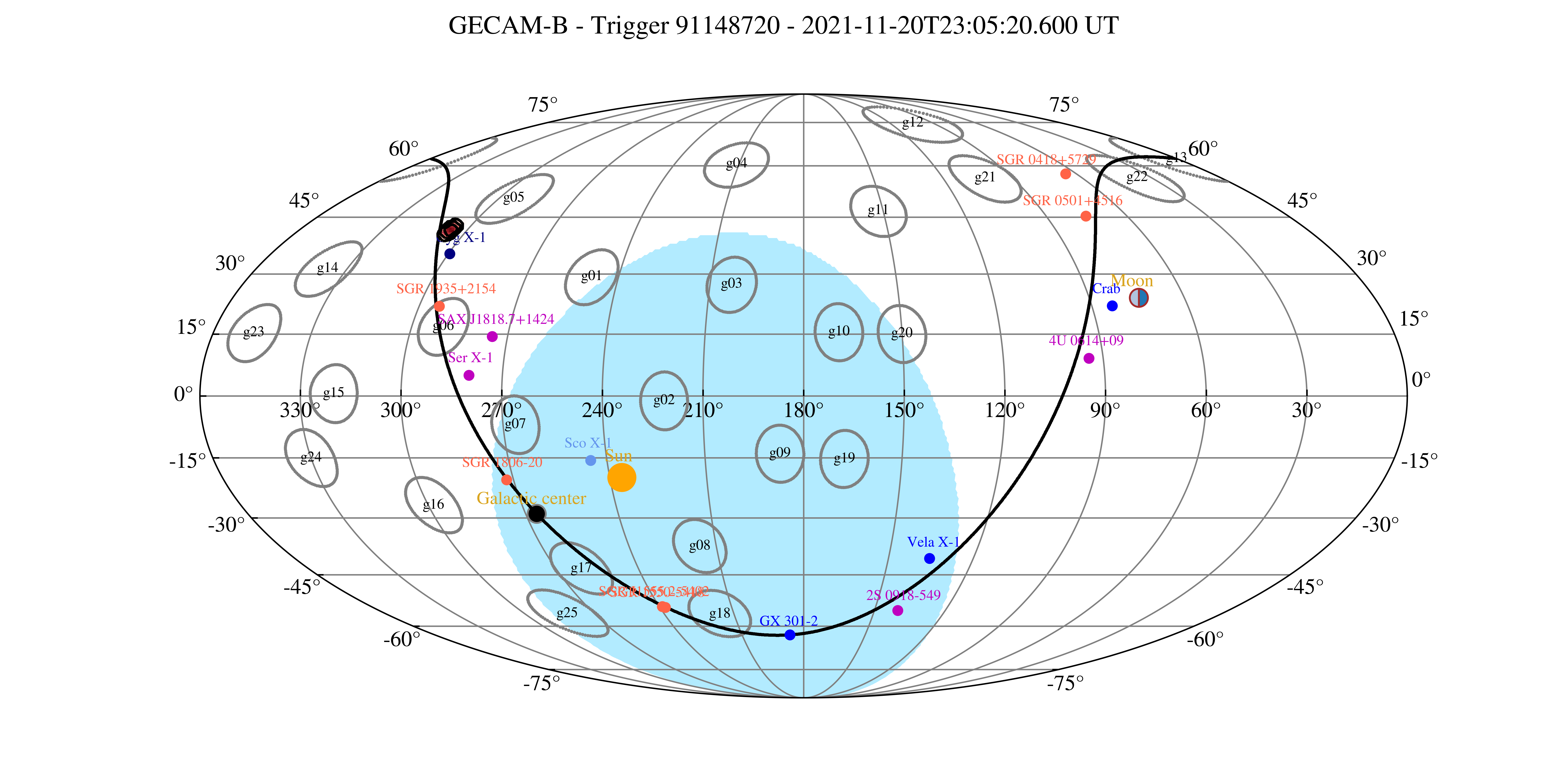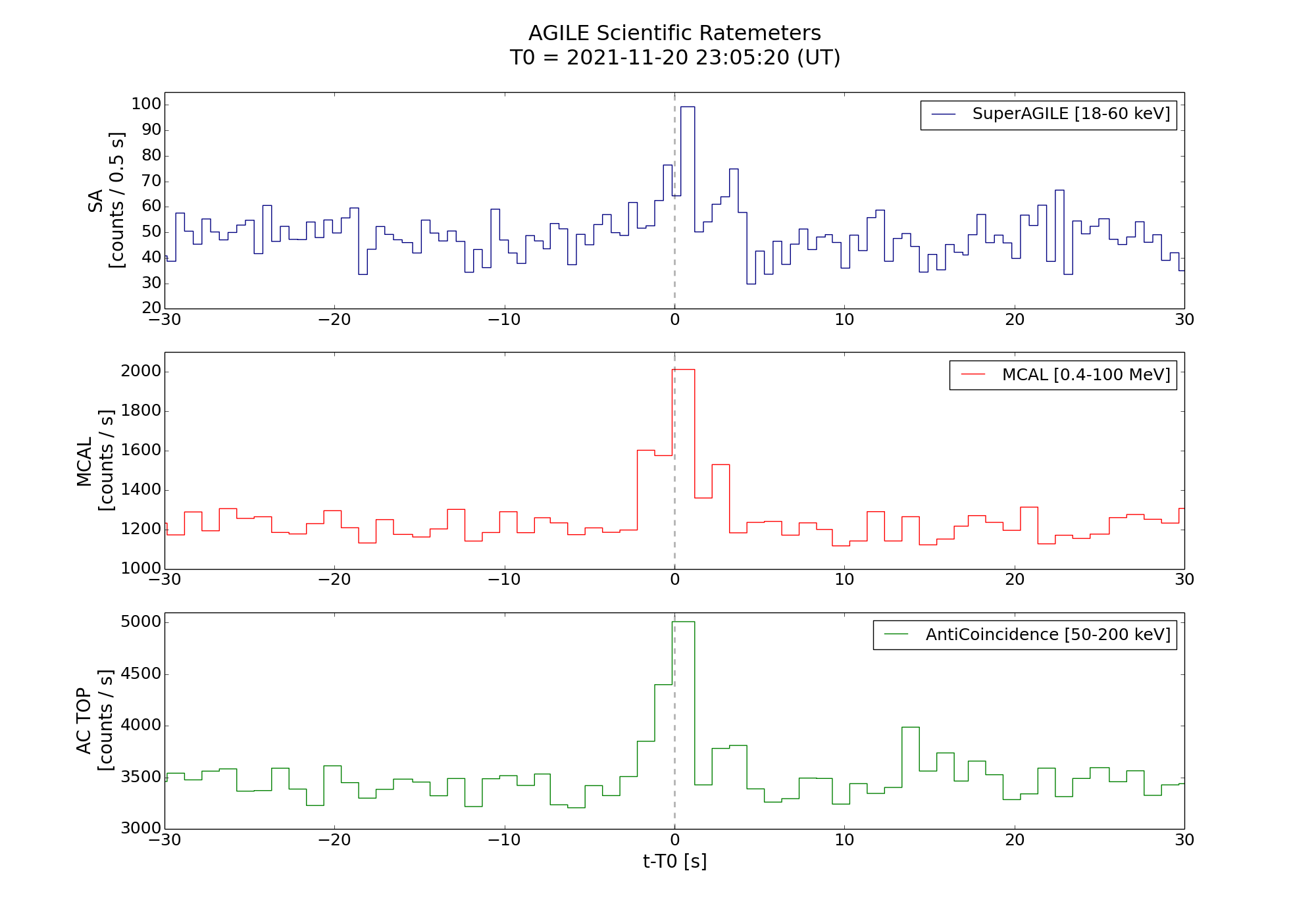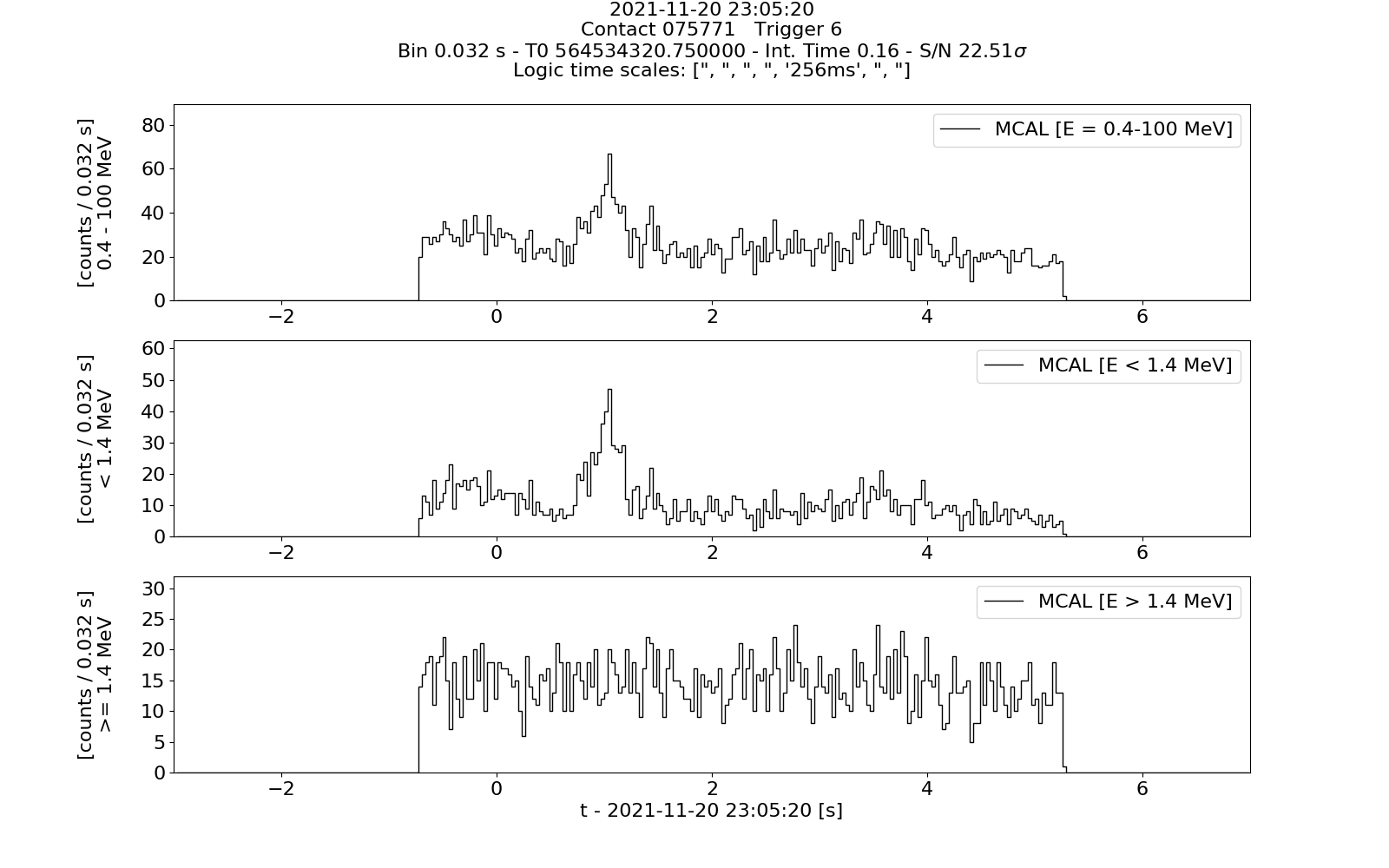- GCN NOTICE
TITLE: GCN/FERMI NOTICE
NOTICE_DATE: Sat 20 Nov 21 13:10:10 UT
NOTICE_TYPE: Fermi-GBM Flight Position
RECORD_NUM: 46
TRIGGER_NUM: 659106591
GRB_RA: 43.100d {+02h 52m 24s} (J2000),
43.464d {+02h 53m 51s} (current),
42.271d {+02h 49m 05s} (1950)
GRB_DEC: +45.100d {+45d 06' 00"} (J2000),
+45.189d {+45d 11' 19"} (current),
+44.895d {+44d 53' 43"} (1950)
GRB_ERROR: 13.38 [deg radius, statistical plus systematic]
GRB_INTEN: 256 [cnts/sec]
DATA_SIGNIF: 11.70 [sigma]
INTEG_TIME: 1.024 [sec]
GRB_DATE: 19538 TJD; 324 DOY; 21/11/20
GRB_TIME: 47386.84 SOD {13:09:46.84} UT
GRB_PHI: 161.00 [deg]
GRB_THETA: 65.00 [deg]
DATA_TIME_SCALE: 1.0240 [sec]
HARD_RATIO: 0.83
LOC_ALGORITHM: 3 (version number of)
MOST_LIKELY: 52% GRB
2nd_MOST_LIKELY: 44% Distant Particles
DETECTORS: 0,0,0, 0,0,0, 1,0,0, 0,0,1, 0,0,
SUN_POSTN: 236.19d {+15h 44m 46s} -19.81d {-19d 48' 29"}
SUN_DIST: 152.52 [deg] Sun_angle= -11.2 [hr] (East of Sun)
MOON_POSTN: 69.48d {+04h 37m 56s} +23.01d {+23d 00' 43"}
MOON_DIST: 30.65 [deg]
MOON_ILLUM: 99 [%]
GAL_COORDS: 144.30,-12.69 [deg] galactic lon,lat of the burst (or transient)
ECL_COORDS: 54.56, 27.26 [deg] ecliptic lon,lat of the burst (or transient)
LC_URL: http://heasarc.gsfc.nasa.gov/FTP/fermi/data/gbm/triggers/2021/bn211120548/quicklook/glg_lc_medres34_bn211120548.gif
COMMENTS: Fermi-GBM Flight-calculated Coordinates.
COMMENTS: This trigger occurred at longitude,latitude = 309.97,21.83 [deg].
COMMENTS: The LC_URL file will not be created until ~15 min after the trigger.
- GCN NOTICE
TITLE: GCN/FERMI NOTICE
NOTICE_DATE: Sat 20 Nov 21 13:10:19 UT
NOTICE_TYPE: Fermi-GBM Flight Position
RECORD_NUM: 58
TRIGGER_NUM: 659106591
GRB_RA: 40.100d {+02h 40m 24s} (J2000),
40.478d {+02h 41m 55s} (current),
39.242d {+02h 36m 58s} (1950)
GRB_DEC: +50.900d {+50d 53' 60"} (J2000),
+50.993d {+50d 59' 35"} (current),
+50.686d {+50d 41' 09"} (1950)
GRB_ERROR: 7.20 [deg radius, statistical plus systematic]
GRB_INTEN: 277 [cnts/sec]
DATA_SIGNIF: 24.10 [sigma]
INTEG_TIME: 4.096 [sec]
GRB_DATE: 19538 TJD; 324 DOY; 21/11/20
GRB_TIME: 47386.84 SOD {13:09:46.84} UT
GRB_PHI: 157.00 [deg]
GRB_THETA: 60.00 [deg]
DATA_TIME_SCALE: 4.0960 [sec]
HARD_RATIO: 0.78
LOC_ALGORITHM: 3 (version number of)
MOST_LIKELY: 69% Distant Particles
2nd_MOST_LIKELY: 29% GRB
DETECTORS: 0,0,0, 0,0,0, 1,0,0, 0,0,1, 0,0,
SUN_POSTN: 236.19d {+15h 44m 46s} -19.81d {-19d 48' 29"}
SUN_DIST: 146.45 [deg] Sun_angle= -11.0 [hr] (East of Sun)
MOON_POSTN: 69.48d {+04h 37m 56s} +23.01d {+23d 00' 44"}
MOON_DIST: 35.86 [deg]
MOON_ILLUM: 99 [%]
GAL_COORDS: 139.90, -8.35 [deg] galactic lon,lat of the burst (or transient)
ECL_COORDS: 54.70, 33.40 [deg] ecliptic lon,lat of the burst (or transient)
LC_URL: http://heasarc.gsfc.nasa.gov/FTP/fermi/data/gbm/triggers/2021/bn211120548/quicklook/glg_lc_medres34_bn211120548.gif
COMMENTS: Fermi-GBM Flight-calculated Coordinates.
COMMENTS: This trigger occurred at longitude,latitude = 309.97,21.83 [deg].
COMMENTS: The LC_URL file will not be created until ~15 min after the trigger.
- GCN NOTICE
TITLE: GCN/FERMI NOTICE
NOTICE_DATE: Sat 20 Nov 21 13:44:07 UT
NOTICE_TYPE: Fermi-GBM Final Position
RECORD_NUM: 0
TRIGGER_NUM: 659106591
GRB_RA: 47.940d {+03h 11m 46s} (J2000),
48.318d {+03h 13m 16s} (current),
47.079d {+03h 08m 19s} (1950)
GRB_DEC: +47.140d {+47d 08' 24"} (J2000),
+47.221d {+47d 13' 17"} (current),
+46.952d {+46d 57' 07"} (1950)
GRB_ERROR: 1.93 [deg radius, statistical only]
GRB_DATE: 19538 TJD; 324 DOY; 21/11/20
GRB_TIME: 47386.84 SOD {13:09:46.84} UT
GRB_PHI: 163.82 [deg]
GRB_THETA: 62.04 [deg]
E_RANGE: 50.000 - 300.000 [keV]
LOC_ALGORITHM: 415 (Gnd S/W Version number)
SUN_POSTN: 236.22d {+15h 44m 52s} -19.81d {-19d 48' 48"}
SUN_DIST: 151.85 [deg] Sun_angle= -11.5 [hr] (East of Sun)
MOON_POSTN: 69.78d {+04h 39m 07s} +23.08d {+23d 04' 32"}
MOON_DIST: 29.64 [deg]
MOON_ILLUM: 99 [%]
GAL_COORDS: 146.27, -9.27 [deg] galactic lon,lat of the burst (or transient)
ECL_COORDS: 58.88, 28.14 [deg] ecliptic lon,lat of the burst (or transient)
LC_URL: http://heasarc.gsfc.nasa.gov/FTP/fermi/data/gbm/triggers/2021/bn211120548/quicklook/glg_lc_medres34_bn211120548.gif
LOC_URL: http://heasarc.gsfc.nasa.gov/FTP/fermi/data/gbm/triggers/2021/bn211120548/quicklook/glg_locplot_all_bn211120548.png
COMMENTS: Fermi-GBM Final Position.
COMMENTS: This Notice was ground-generated -- not flight-generated.
COMMENTS: The LC_URL file should be available by the time this FINAL notice is produced.
COMMENTS: This notice has human-in-the-loop processing.
- GCN Circular #31100
C. Y. Li, S. L. Xie, S. L. Xiong, S. Xiao, C. Cai, X. Y. Zhao, Y. Huang, X. Y. Song,
J. C. Liu, Y. Q. Zhang, Y. Zhao, Z. W. Guo, C. Zheng, W. C. Xue, C. W. Wang,
Q. B. Yi, B. X. Zhang, P. Zhang, W. X. Peng, R. Qiao, D. Y. Guo,
X. B. Li, X. Ma, P. Wang, J. Wang, Z. Zhang, S. J. Zheng, W. Chen, J. J. He,
G. Y. Zhao, Y. Q. Du, H. Wu, J. Liang, Q. Luo, X. L. Zhang,
L. M. Song, F. J. Lu, S. N. Zhang (IHEP), report on behalf of GECAM team:
During the commissioning phase, GECAM-B was triggered in-flight by a long
burst, GRB 211120A, at 2021-11-20T23:05:20.600 UTC (denoted as T0).
GECAM alert data was downlinked to the ground through the short message
service of BeiDou Navigation Satellite System (BDS) within ~60 s after T0.
According to the BDS alert data, this burst mainly consists of a broad pulse
with a duration of about 6 s.
The GECAM light curve could be found here:
http://twiki.ihep.ac.cn/pub/GECAM/GRBList/gecamb_lc_grd_all_combine_91148720.png
Using the automatic on-ground localization pipeline with the BDS alert data,
GECAM-B localized this burst to the following position (J2000):
Ra: 304.99 deg
Dec: 41.42 deg
Err: 1.34 deg (1-sigma, statistical only)
The current systematic error of location is estimated to be several degrees
which could be minimized by the ongoing calibration.
The GECAM preliminary location could be found here:
http://twiki.ihep.ac.cn/pub/GECAM/GRBList/gecamb_skymap_bdm_91148720_V01.png
Given that the location is consistent with the Galactic plane, we cannot rule
out the galactic origin of this burst.
Please note that all GECAM results here are preliminary. The final analysis
will be published in journal papers or GECAM online catalog.
Gravitational wave high-energy Electromagnetic Counterpart All-sky Monitor
(GECAM) mission consists of two small satellites (GECAM-A and GECAM-B) in
Low Earth Orbit (600 km, 29 deg), launched on Dec 10, 2020 (Beijing Time),
which was funded by the Chinese Academy of Sciences (CAS).


- GCN Circular #31104
V. Prasad (IUCAA), P. Sawant (IUCAA), G. Waratkar (IITB), A. Vibhute
(IUCAA), V. Bhalerao (IITB), D. Bhattacharya (IUCAA), A. R. Rao
(IUCAA/TIFR), and S. Vadawale (PRL) report on behalf of the AstroSat
CZTI collaboration:
Analysis of AstroSat CZTI data with the CIFT framework (Sharma et al.,
2021, JApA, 42, 73) showed detection of a long GRB 211120A, which was
also detected by GECAM (Li et al., GCN 31100).
The source was clearly detected in the 20-200 keV energy range. The
light curve showed multiple peaks of emission with the strongest peak at
2021-11-20 23:05:22.85 UT. The measured peak count rate associated with
the burst is 1756 (+251, -174) cts/s above the background in the
combined data of two quadrants, with a total of 2263 (+183, -134) cts.
The local mean background count rate was 443 (+4, -8) cts/s. Using
cumulative rates, we measure a T90 of 4.8 (+0.6, -0.2) s.
It was also clearly detected in the CsI anticoincidence (Veto) detector
in the 100-500 keV energy range.
CZTI GRB detections are reported regularly on the payload site at
http://astrosat.iucaa.in/czti/?q=grb [1]. CZTI is built by a TIFR-led
consortium of institutes across India, including VSSC, ISAC, IUCAA, SAC,
and PRL. The Indian Space Research Organisation funded, managed and
facilitated the project.
Links:
------
[1] http://astrosat.iucaa.in/czti/?q=grb
- GCN Circular #31105
A. Ursi (INAF/IAPS), C. Pittori (SSDC, and INAF/OAR), A. Trois
(INAF/OA-Cagliari), M. Tavani (INAF/IAPS, and Univ. Roma Tor Vergata), A.
Argan, M. Cardillo, C. Casentini, Y. Evangelista, E. Menegoni, L. Foffano,
G. Piano (INAF/IAPS), F. Lucarelli, F. Verrecchia (SSDC, and INAF/OAR), A.
Bulgarelli, A. Di Piano, V. Fioretti, F. Fuschino, N. Parmiggiani
(INAF/OAS-Bologna), M. Marisaldi (INAF/OAS-Bologna, and Bergen University),
M. Pilia (INAF/OA-Cagliari), I. Donnarumma (ASI), F. Longo (Univ. Trieste
and INFN Trieste), A. Giuliani (INAF/IASF-Mi), report on behalf of the
AGILE Team:
The AGILE satellite detected the GRB 211120A at T0 = 2021-11-20 23:05:20
(UTC), reported by GECAM (GCN #31100) and AstroSat CZTI (GCN #31104).
The burst is clearly visible in the AGILE scientific ratemeters of the
SuperAGILE (SA; 20-60 keV), MiniCALorimeter (MCAL; 0.4-100 MeV), and
AntiCoincidence (AC; 50-200 keV) detectors. The event lasted about 6 s and
it released a total number of 821 counts in the SA detector (above a
background rate of 96 Hz), 9275 counts in the MCAL detector (above a
background rate of 1210 Hz), and 23969 counts in the AC detector (above a
background rate of 3440 Hz). The AGILE ratemeter light curves can be found
at http://www.agilescienceapp.it/notices/GRB211120A_AGILE_RM.png .
The event also triggered a partial high time resolution MCAL data
acquisition, covering the main peak of the burst, from T1 = 2021-11-20
23:05:20.0 s +/- 0.5 (UTC) to T2 = 2021-11-20 23:05:26.0 +/- 0.5 s (UTC),
and released 2291 counts in the detector, above a background rate of 710
Hz. The time-integrated spectrum of the burst between T1 and T1+2.43 s can
be fitted in the energy range 0.4-20 MeV with a single power-law with ph.
ind. = -2.43 (-0.34/+0.44), resulting in a reduced chi-squared of 1.09 (62
d.o.f.) and a fluence of 5.9e-06 ergs/cm^2 (90% confidence level), in the
same energy range. The MCAL light curve can be found at:
http://www.agilescienceapp.it/notices/GRB211120A_MCAL.png .
Additional analysis of AGILE data is in progress. Automatic MCAL GRB alert
Notices can be found at: https://gcn.gsfc.nasa.gov/agile_mcal.html. Please
note that in the MCAL notice #564534599 the T0 was affected by a temporal
shift of about +279 sec due to a temporary ground software problem now
solved.


- GCN Circular #31129
A.S. Kozyrev, D.V. Golovin, M.L. Litvak, I.G. Mitrofanov, and A.B. Sanin
on behalf of the MGNS/BepiColombo and HEND/Mars Odyssey teams,
J. Benkhoff on behalf of the BepiColombo team,
K. Hurley on behalf of the IPN,
D. Svinkin, S. Golenetskii, D. Frederiks, A. Ridnaia,
A. Lysenko, and T. Cline on behalf of the Konus-Wind team,
and
W. Boynton, C. Fellows, K. Harshman, H. Enos, and R. Starr,
on behalf of the GRS-Odyssey GRB team, report:
The long-duration GRB 211120A
(GECAM-B detection: Li et al., GCN Circ. 31100;
AstroSat-CZTI detection: Prasad et al., GCN Circ. 31104;
AGILE-MCAL detection: Ursi et al., GCN Circ. 31105)
was detected by GECAM-B (GRD), AstroSat (CZTI), AGILE (MCAL),
Konus-Wind, Mars-Odyssey (HEND),
and BepiColombo (MGNS; see introductory GCN Circ. 30949)
at about 83120 s UT (23:05:20).
We have triangulated it to a preliminary, 3 sigma error box
whose coordinates are:
---------------------------------------------
RA(2000), deg Dec(2000), deg
---------------------------------------------
Center:
315.138 (21h 00m 33s) +42.856 (+42d 51' 20")
Corners:
315.108 (21h 00m 26s) +43.024 (+43d 01' 25")
315.128 (21h 00m 31s) +42.774 (+42d 46' 28")
315.185 (21h 00m 44s) +42.640 (+42d 38' 25")
315.164 (21h 00m 39s) +42.890 (+42d 53' 23")
---------------------------------------------
The error box area is 30 sq. arcmin, and its maximum
dimension is 23 arcmin (the minimum one is 0.7 arcmin).
The Sun distance was 95 deg.
This box may be improved.
The distance between the box and the GECAM position
(RA, Dec, Err = 304.99, 41.42, 1.34; GCN 31100) is
7.6 deg, thus it is inconsistent with the box.
The box Galactic latitude is -2.2 deg (noticed by Shaolin XIONG),
so the Galactic origin can not be ruled out
using the burst localization only.
A triangulation map is posted at
http://www.ioffe.ru/LEA/GRBs/GRB211120_T83120/IPN/
The Konus-Wind time history and spectrum will be given in a forthcoming
GCN Circular.
- GCN Circular #31130
D. Frederiks, S. Golenetskii, A.Lysenko, A. Ridnaia,
D. Svinkin, A. Tsvetkova, M. Ulanov, and T. Cline,
on behalf of the Konus-Wind team, report:
The long GRB 211120A (GECAM detection: Li et al., GCN 31100;
AstroSat CZTI detection: Prasad et al., GCN 31104;
AGILE detection: Ursi et al., GCN 31105;
IPN localization: Kozyrev et al., GCN 31129)
triggered Konus-Wind (KW) at T0=83120.396 s UT (23:05:20.396).
The burst light curve shows a bright, multi-peaked pulse
which starts at ~T0-1 s and has a total duration of ~8 s.
The emission is seen up to ~10 MeV.
The Konus-Wind light curve of this GRB is available at
http://www.ioffe.ru/LEA/GRBs/GRB211120_T83120/
As observed by Konus-Wind, the burst had
a fluence of (3.5 ± 0.4)x10^-5 erg/cm^2 and
a 64-ms peak energy flux, measured from T0 + 1.984 s,
of (2.4 ± 0.2)x10^-5 erg/cm^2/s (both in the 20 keV - 10 MeV energy range).
The time-integrated spectrum (measured from T0 to T0+5.120 s)
is best fit in the 20 keV - 15 MeV range
by the GRB (Band) function with the following model parameters:
the low-energy photon index alpha = -0.65 (-0.07,+0.08),
the high energy photon index beta = -2.71 (-0.30,+0.20),
the peak energy Ep = 315 (-24,+24) keV,
chi2 = 113/95 dof.
The spectrum near the peak count rate (measured from T0+0.256
to T0+3.072 s) is best fit in the 20 keV - 15 MeV range
by the GRB (Band) function with the following model parameters:
the low-energy photon index alpha = -0.55 (-0.10,+0.12),
the high energy photon index beta = -2.48 (-0.28,+0.18),
the peak energy Ep = 325 (-36,+40) keV,
chi2 = 96/84 dof.
All the quoted errors are estimated at the 90% confidence level.
All the presented results are preliminary.
- GCN Circular #31131
R. Dunwoody (UCD), J.Mangan (UCD) and C.Meegan (UAH)
report on behalf of the Fermi GBM Team:
"At 13:09:46.84 UT on 20 November 2021, the Fermi Gamma-Ray Burst Monitor
(GBM)
triggered and located GRB 211120B (trigger 659106591 / 211120548).
which was also detected by the Swift/BAT-GUANO (DeLaunay et al. 2021, GCN
31101)
The GBM on-ground calculated location, using the GBM trigger
data, is RA = 47.9, DEC = 47.1 (J2000 degrees,
equivalent to 03 h 11 m, 47 d 6 '), with a statistical uncertainty
of 1.9 degrees (radius, 1-sigma containment, statistical only;
there is additionally a systematic error which we have characterized as a
core-plus-tail model,
with 90% of GRBs having a 3.7 deg error and a small tail suffering
a larger than 10 deg systematic error. [Connaughton et al. 2015, ApJS, 216,
32] )
The angle from the Fermi LAT boresight at the GBM trigger time is 62
degrees.
The GBM light curve consists of a single peak
with a duration (T90) of about 36.1 s (50-300 keV).
The time-averaged spectrum from T0-6.400 s to T0+33.537 s is
best fit by a power law function with an exponential
high-energy cutoff. The power law index is -0.99 +/- 0.04 and
the cutoff energy, parameterized as Epeak, is 298.2 +/- 26.3 keV
The event fluence (10-1000 keV) in this time interval is
(1.184 +/- 0.60)E-05 erg/cm^2. The 1-sec peak photon flux measured
starting from T0+1.28 s in the 10-1000 keV band
is 6.5 +/- 0.2 ph/s/cm^2.
A Band function fits the spectrum equally well
with Epeak= 180.1 +/- 24.3 keV, alpha = -0.79 +/- 0.08 and beta = -1.87 +/-
0.08.
The spectral analysis results presented above are preliminary;
final results will be published in the GBM GRB Catalog:
https://heasarc.gsfc.nasa.gov/W3Browse/fermi/fermigbrst.html
For Fermi GBM data and info, please visit the official Fermi GBM Support
Page:
https://fermi.gsfc.nasa.gov/ssc/data/access/gbm/"
![]() Previous IAU Circulars
Previous IAU Circulars 


